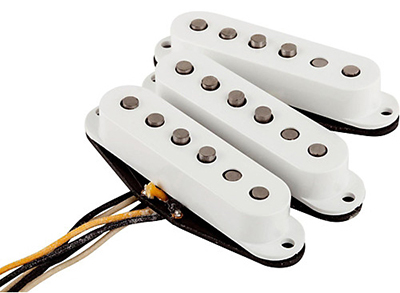
By Ed Malaker
Posted 06/09/2020
Single-coils are well-known for being noisy, and that’s because they are very similar in design to an AM radio antenna. Single-coil pickups exhibit many of the same tendencies to collect noise from the air. Humbucker pickups use two coils wound in opposite directions to cancel out the noise, but those pickups are known for having a warmer sound that’s quite different from that of a single-coil. Die-hard fans of the single-coil may not like the sound of a humbucker though, and the only noise-cancelling option left is to try shielding the guitar.
What is Shielding?
Shielding is placing a grounded conductive material – in this case, copper tape – close to a device carrying electrical current, with the hope of attracting and trapping airborne interference before it enters the signal. In essence, we are building a Faraday cage.
Shielding Limitations
Shielding can only reduce the noise in single-coil pickups because interference comes from other sources besides the air — mainly in the form of a 60-cycle hum created by the electricity in your walls. If your guitar is considerably noisy as it is, you can expect to get a noticeable improvement from the shielding, but it will not be as effective as a humbucker at canceling noise.
Is It Worth It?
We recommend shielding your guitar because it only takes an hour or two. Any noise reduction is worth the time investment, especially if you record. There’s no reason not to take any advantage available to you.
Tools and Items
- A roll of copper tape, aluminum tape, aluminum foil, or metallic paint
- Screwdriver
- Soldering gun
- Solder
How to Shield Single-Coil Pickups
Once we have our tools and items collected, we can get started shielding our pickups.
Step 1: Remove the Pickups and Electronics
If you have a guitar like a Fender Stratocaster, all of the electronics are attached to the pickguard and you can just remove it and finish this step. Other guitars will have different needs. A Fender Telecaster, for instance, uses a pickguard to hold the pickups, while the electronics are in a separate compartment. Make sure you take a picture or write down exactly how everything goes so you can put it back.
Step 2: Shield the Cavities
With the electronics removed, apply the copper tape to all cavities, taking care to cover as much of the surface inside the cavities as possible. The adhesive on the copper tape is conductive so that you can overlap it without worry, but if you’re using aluminum tape or something else, you will need to make sure there is a connection between the layers. If there are separate cavities, like in a Telecaster, you will need to make sure there is a connection between the tape in each cavity. If you cannot make the tape physically touch, you will need to use a wire to connect them. Bare bus wire works well if you do not have any other bare wires running through the hole. Solder each end of the wire to the tape in its cavity. Use a digital voltmeter to test that all shielding is connected.
Step 3: Shield the Pickguard and Coverplates
With the guitar shielded, we need to shield the pickguard and any cover plates. This process is exactly the same and only requires covering as much of the inside surface as possible with the conductive copper tape. You will need to remove any electronics attached to these parts to get good coverage. When the surface is covered, if you were to put it in place, the copper tape on the guitar should touch the copper tape on the pickguard, creating a metal box. The same for any cover plates.
Step 4: Replace the Electronics
Once you have all of the surface areas covered, and you have tested it to see that it creates a metal box, replace all of the electronics precisely as you have found them. It’s good practice to remove the ground wires from the tone control and the volume control to avoid a ground loop.
Step 5: Replace the Pickguard and the Coverplates
Once the electronics are all in place, you just need to solder a wire from the copper tape to the back of the volume pot and replace the covers and pickguard.
Conclusion
Shielding single-coil pickups will attract, trap and shuttle to ground RF and electromagnetic interference similar to how your body does when you touch the strings. The tops of the pickups are still exposed and will allow noise to enter, but you should definitely notice an improvement. If you shield your guitar and you still experience a lot of hum, the only solution may be a stacked humbucker to remove the noise properly.
If you have enjoyed reading this shielding single-coil pickups guide and have found it helpful, please feel free to share it on Facebook and Twitter. For more articles on guitar electronics, visit humbuckersoup.com.
